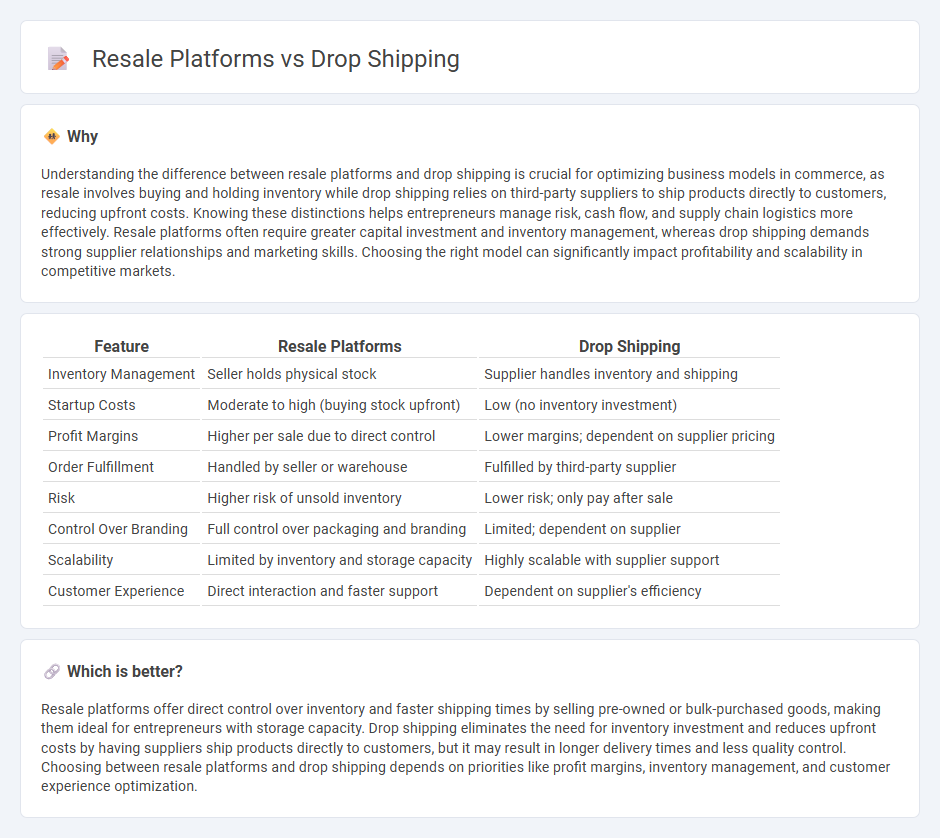
Resale platforms enable individuals to sell pre-owned or excess inventory directly to consumers, often providing a curated marketplace with established customer trust and faster shipping times. Drop shipping allows retailers to sell products without holding inventory, relying on suppliers to ship items directly to customers, which minimizes upfront costs but can lead to longer delivery times and less control over product quality. Explore the key differences between resale platforms and drop shipping to optimize your e-commerce strategy.
Why it is important
Understanding the difference between resale platforms and drop shipping is crucial for optimizing business models in commerce, as resale involves buying and holding inventory while drop shipping relies on third-party suppliers to ship products directly to customers, reducing upfront costs. Knowing these distinctions helps entrepreneurs manage risk, cash flow, and supply chain logistics more effectively. Resale platforms often require greater capital investment and inventory management, whereas drop shipping demands strong supplier relationships and marketing skills. Choosing the right model can significantly impact profitability and scalability in competitive markets.
Comparison Table
| Feature | Resale Platforms | Drop Shipping |
|---|---|---|
| Inventory Management | Seller holds physical stock | Supplier handles inventory and shipping |
| Startup Costs | Moderate to high (buying stock upfront) | Low (no inventory investment) |
| Profit Margins | Higher per sale due to direct control | Lower margins; dependent on supplier pricing |
| Order Fulfillment | Handled by seller or warehouse | Fulfilled by third-party supplier |
| Risk | Higher risk of unsold inventory | Lower risk; only pay after sale |
| Control Over Branding | Full control over packaging and branding | Limited; dependent on supplier |
| Scalability | Limited by inventory and storage capacity | Highly scalable with supplier support |
| Customer Experience | Direct interaction and faster support | Dependent on supplier's efficiency |
Which is better?
Resale platforms offer direct control over inventory and faster shipping times by selling pre-owned or bulk-purchased goods, making them ideal for entrepreneurs with storage capacity. Drop shipping eliminates the need for inventory investment and reduces upfront costs by having suppliers ship products directly to customers, but it may result in longer delivery times and less quality control. Choosing between resale platforms and drop shipping depends on priorities like profit margins, inventory management, and customer experience optimization.
Connection
Resale platforms facilitate the sale of pre-owned or new products directly from sellers to buyers, often leveraging drop shipping methods to streamline inventory management and order fulfillment. Drop shipping enables sellers on resale platforms to list products without holding stock, as suppliers ship items directly to customers, reducing overhead costs and risks. This synergy allows commerce businesses to expand product offerings efficiently while minimizing logistical complexities.
Key Terms
Inventory Management
Dropshipping minimizes inventory management by relying on suppliers to handle stock and shipping, reducing overhead costs and risks associated with unsold products. Resale platforms require sellers to maintain physical inventory, demanding more intensive tracking, storage solutions, and capital investment. Discover detailed strategies to optimize inventory management for both business models.
Fulfillment Process
Dropshipping relies on suppliers directly shipping products to customers, eliminating inventory management and reducing overhead costs, while resale platforms require sellers to store, package, and fulfill orders themselves, ensuring greater control over the fulfillment process but increased responsibility. Dropshipping's fulfillment speed depends heavily on suppliers' efficiency and locations, which can lead to variable delivery times, whereas resale platforms typically provide faster shipping through centralized inventory management. Discover more about how fulfillment impacts profitability and customer satisfaction in both models.
Profit Margins
Dropshipping typically offers lower profit margins, ranging from 10% to 30%, due to supplier fees and lack of bulk purchasing discounts. Resale platforms, especially those involving inventory purchase, can achieve higher margins of 40% or more, benefiting from wholesale prices and control over product pricing. Explore detailed comparisons and strategies to maximize your profit margins in both models.
Source and External Links
Drop shipping - Wikipedia - Drop shipping is a retail business model where the seller takes customer orders without holding inventory and forwards these orders to a manufacturer or wholesaler who ships directly to the customer, reducing upfront costs but limiting control over product quality and shipping.
What Is Dropshipping and How Does It Work? (2025) - Shopify - Dropshipping involves partnering with a supplier who stores, packages, and ships products directly to customers after the store owner receives the order, allowing the retailer to sell without managing inventory or fulfillment.
What Is Dropshipping and How Does It Work? - Wix.com - Dropshipping lets retailers run an online store without owning inventory by purchasing items from a third-party supplier as orders come in, focusing primarily on marketing and customer service while the supplier handles production and shipping.
 dowidth.com
dowidth.com